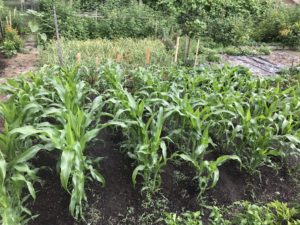Gardening without Land Access
Gardening without land is very doable. With this in mind, patios and balcony’s are great places to garden. Specifically residing in a condo or apartments does not mean you can not have a viable garden space. Using containers for gardening works for all annual vegetables if there is no space for traditional garden beds. Alternatively, urban homesteaders can look to expand their available ground to work in by joining a community garden. Volunteering to work at a community-run garden or at a friend’s property are additional avenues.
Patio / Balcony Gardening
Growing vegetables on a ground floor patio or balcony at a townhouse, condominium, or apartment is a great option. Spaces often left void of plants can be gardened to provide tasty herbs, vegetables, and even fruits. Gardening on a balcony requires thoughtful planning and the use of containers. However, it does not need to be limited to just simple herbs and flowers. A balcony that receives ample light with enough space for a large pot can be home to a fruit tree or two or several planter boxes with annual veggies.
Container Gardening
Container gardening is perfect for people with limited access to space for an in-ground garden. Gardening in containers is the preferred method for growing vegetables, fruits, and herbs on a patio or balcony. Use small pots for herbs and flowers and larger containers for dwarf fruit trees, shrubs, and annual vegetables.
A container can be made from anything that holds soil and will properly drain water. Typical containers include standard pots from a garden center. Likewise, you can create 5-gallon bucket container gardens for a very low cost and grow a ton of food. A 5-gallon bucket with holes drilled into the bottom is the perfect size for growing and harvesting potatoes, tomatoes, peppers, kale, and more.
Options for containers are endless. A popular method for container gardens is root pouch grow bags. These are made from recycled material and have the feel of fabric. They can be folded up and stored easily during the off-season and come in every size imaginable from 1 gallon to 100 gallon, big enough for full-size trees to thrive.

Community Gardening
Many municipalities support gardening through their parks and recreation departments. Inquire with the local parks bureau where you live about opportunities to garden. A community garden plot is an excellent way for anyone to gain access to land with good sunlight and soil. The community garden plot may be as small as a 4×8 foot raised bed or as large as 1000 square feet depending on the design of the garden and available land plots.
Most community gardens come with water access and a tool shed making gardening accessible for all. Consequently, community gardens also come with rules to follow which may include completing so many hours of service to help tend to the community portions of the garden such as the paths, surrounding space, etc.

Guerilla Gardening / Guerilla Grafting
The act of growing plants on public or private property that you do not own is guerilla gardening. Guerilla grafting is identifying graftable trees in public spaces and grafting fruiting varieties to the tree. Both of these strategies have their risks of being destroyed by the property owner and the work done being lost. However, when done with that understanding guerilla gardening can be an option to green up a run-down empty lot. It is always best to garden with the permission of the property owner so ask if you can before you start planting. Granted that there are worse things in the world than planting some kale and giving it water, but it is best to respect others’ property when there are so many other avenues for accessing land to grow on for free or with little cost.
Volunteering
Volunteer with a local community gardening project or at an urban farm nearby. As a matter of fact, putting in some time on another person’s project is a great way to learn vegetable and fruit growing skills. Furthermore, you may get to enjoy some of the harvests. I see permaculture projects nearby offering time to work in their food forests and sharing the bounty with those that help. There may be a local fruit growing society with a couple of acres of fruit trees that require annual maintenance and for providing work you can earn a share of fruit in the fall. Don’t be afraid to ask for the opportunity to help out and do the work. Volunteering to work on someone else’s land with an open eye can help hone in your mind the type of urban homestead you desire to build one day.
Ask a Friend
Similar to volunteering, asking a friend may be fruitful. In fact, they may be very excited to have someone help build a garden on their land. In return for the support provided, you may get to work a piece of land and reap the harvest for your efforts.
Gardening and building food forests are accessible to those that seek out the opportunities to have them. Whether this is through taking small steps such as starting a container garden or accessing land through a community garden or friend. Never let the lack of access to your own property stop you from growing a garden on your own, with friends, and the greater community.



Recent Comments